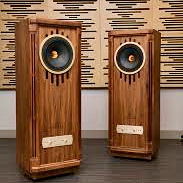
Tannoy kensington GR
And yes, we have one of the mid-sized models on test. Even a quick listen proves there’s more at work here than just nostalgia. Also, when we say mid-sized, it’s only in the context of the range. It’s still a large cabinet, 105 litres in volume and 110 cm tall. Packaged, these speakers weigh in at a hefty 49kg each, so make sure you have a willing friend to help unpack them.
Once unpacked, you’ll find the Kensington GRs perfectly made. Also, more expansive than deep and covered with many retro design details. The cabinets are solid, using a mixture of high-density birch ply for the front baffle and rear panel, combined with particle board and solid wood for other sections.
There are two standard finishes; the traditional-looking Walnut most Tannoy Prestige speakers or the Black Oak. Also, loads of neat cosmetic touches. We love the GR (Gold Reference) emblem on the front baffle and the engraved thick metal plate used for the treble adjustment section. The surprisingly heavy grille locks into place, and a chunky key unlocks it for removal.
Tannoy finish
Items such as the beautifully finished wooden box that houses the bi-wire links, spikes, and the nicely produced manual help promote pride of ownership. Details like this boost the feel-good factor. But, despite all the fancy woodwork, the heart of these speakers is Tannoy’s trademark Dual Concentric drive unit. The one used in the Kensington GR builds on decades of development. It has a 25-cm paper pulp mid/bass cone with an impregnated twin roll fabric surround.
The tweeter – positioned in the heart of the mid/bass to help integration – is a 52mm aluminium/magnesium dome. It fires through a ‘pepper pot’ grating into a stainless steel horn – an arrangement said to help sensitivity and control directivity. We don’t usually mention the magnet material used in a drive unit, but here we’ll make an exception. The Dual Concentric driver uses an Alnico magnet to provide the driving force for both the low- and high-frequency drivers.
Tannoy claims using Alnico (an iron/nickel alloy with cobalt, aluminium and other rare metals) helps give the drive unit array a cleaner transient response and increased sensitivity. Also, the size of the Kensington means you’ll need a big room – around 20 square metres as a minimum. So, place these floor standers at least a metre into the room to make the most of their stereo imaging.
Listening room
In our listening room, any closer to the rear or sidewalls resulted in an unnatural bloom at low frequencies. It isn’t particularly severe, but enough to adversely affect the overall performance. Tannoy provides a reasonable degree of flexibility in the treble. And you’ll find adjustments for treble energy and roll-off on the front baffle. These are subtle enough to be helpful, so it’s well worth experimenting to optimise performance.
The Kensington GRs can be bi-wired and benefit from that, sounding more precise and lucid when used this way. As with other Tannoys, there’s an additional terminal next to the two pairs of signal inputs, the use of which (wired to the ground pin on your amplifier) results in a cleaner, crisper presentation.
Impression
Effortless – is our first impression of the Kensington GR’s sound. They’ll deliver a piece of music like Hans Zimmer’s Where We’re Going (from InterstellarOST) with breathtaking composure. Also, the significant dynamic shifts of the track rendered with impressive force, and the scale of sound is just massive. Yet, it’s all done with an incredible sense of ease. These speakers do not sound strained or close to their limits, even at high volumes.
Both the hardness of lesser speakers when pushed and the restrained dynamics go with small drive units and compact cabinets. Then, there’s the bass. While it comes as no surprise a speaker this size produces lots of it, we’re impressed by the Tannoy’s quality. They’re subtle, textured and articulate.
Rivals from the likes of B&W and Focal deliver more punch and grip but sacrifice a little grace in the process. It’s a trade-off we’re happy to accept. We’re impressed with Tannoy’s stereo imaging too. Positioned with care, these speakers set up a broad, deep sound stage populated by securely focused instruments. Again, the stability is impressive, with the precision unspoiled even when louder elements come into play.
Music
With Nina Simone’s Feeling Good, the Kensingtons continue to shine. That Dual Concentric driver gives a seamless and direct delivery, rendering Simone’s vocals with passion and drive. Again, we’re reminded just how subtle and insightful these speakers are, along with the power. We listened to alt-J’s Hunger of the Pine and are struck by the Tannoy’s rhythmic skill. The presentation is gentler than we’re used to, but there’s still enough energy to satisfy. Combining fine timing, solid dynamics, and clarity is enough to win us.
The Kensington GRs are speakers to love. Their retro appearance may not be to all tastes, but there’s enough sonic quality to place them on the top rung of speakers at this price. They’re gentle giants, balancing finesse with force in a mighty appealing way. And if you have enjoyed reading ‘Tannoy Kensington GR review’, please share with friends.
Author: What Hi-Fi, London UK
Date: `13/07/2015
Perkune audiophile cables I professional service